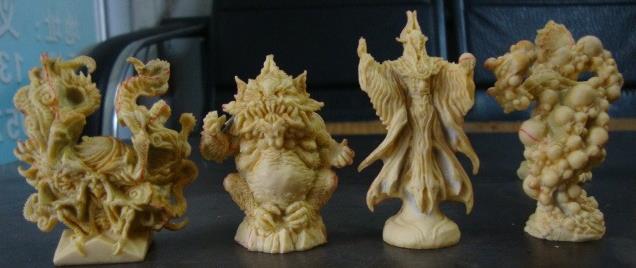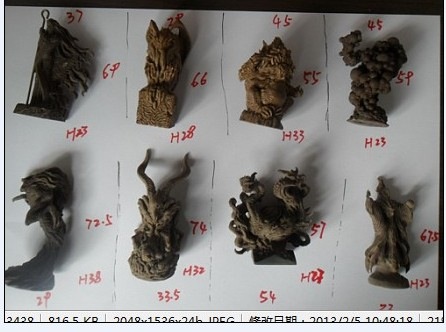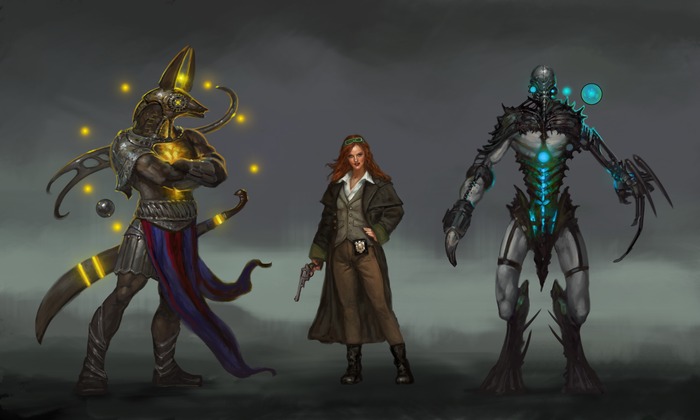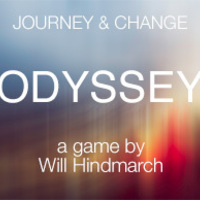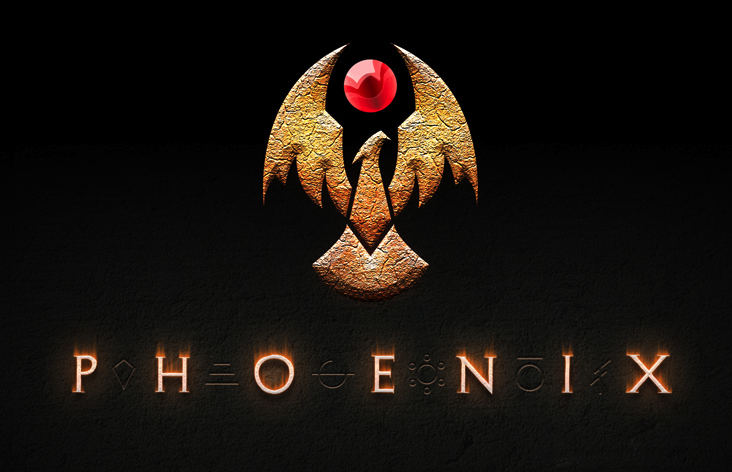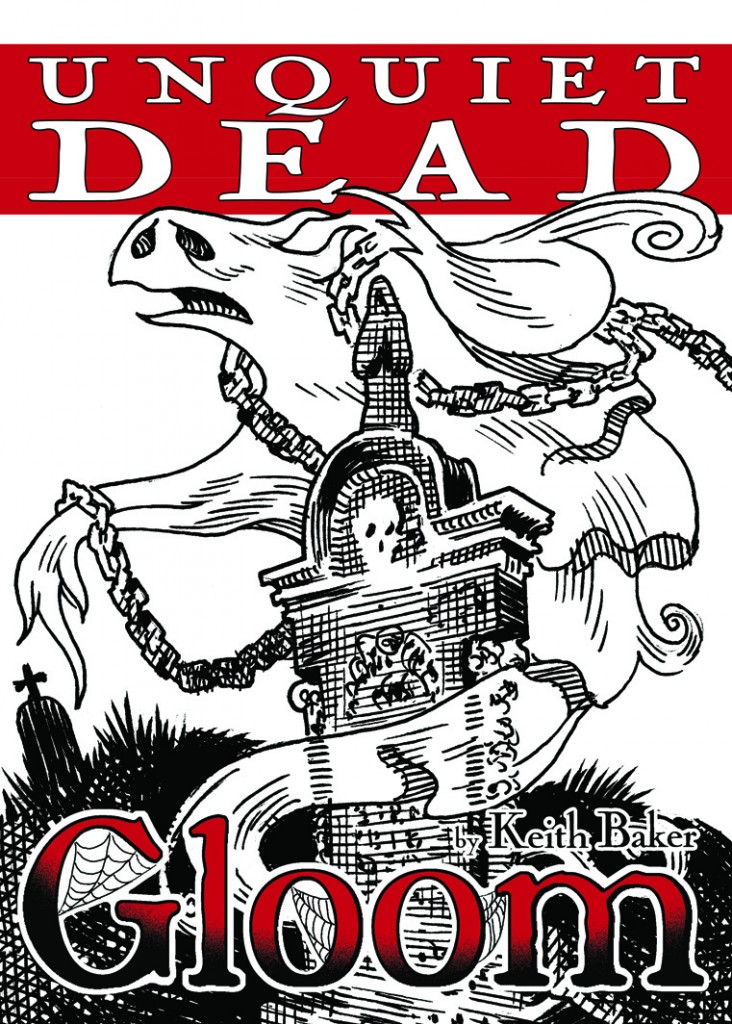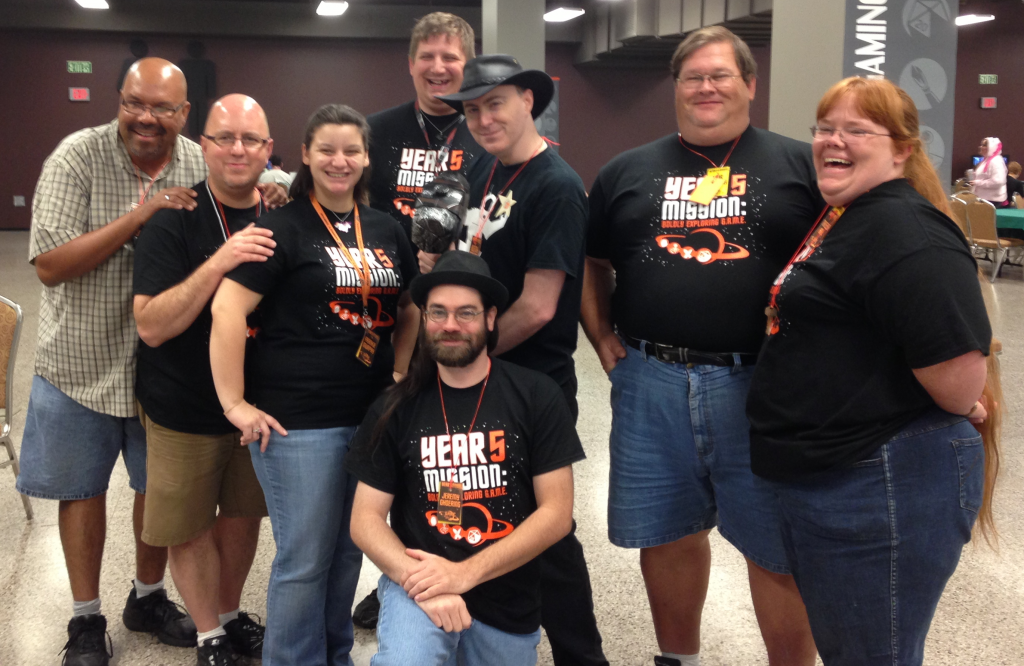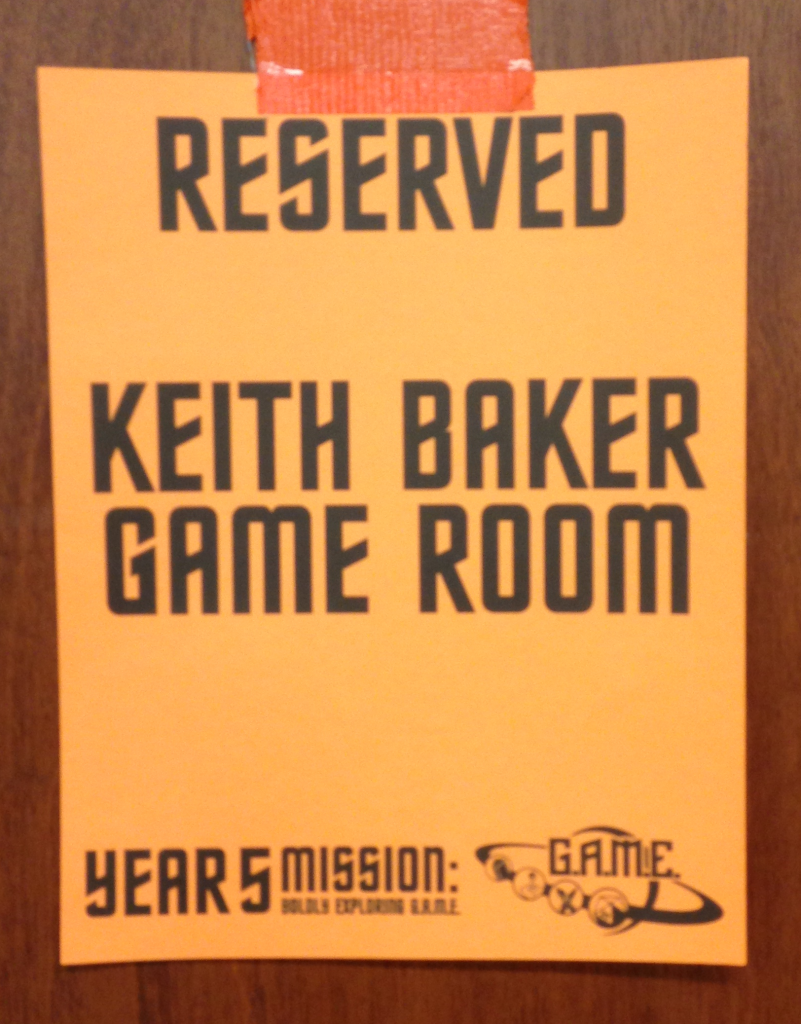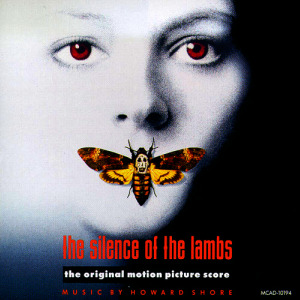It’s still convention season for me. I just got back from a fantastic weekend at G.A.M.E. in Missouri, and next weekend I’ll be in Seattle for GeekGirlCon. I look forward to writing about G.A.M.E. and about Phoenix, which I tested there and will be testing at GGC. But today seemed like a good time to address one player’s concerns about the deplorable state of healthcare in Eberron, so it’s time for another Q&A! As always, everything said here is just my opinion based on my personal campaign, and it may contradict canon sources.
I have a real problem with the ability of Artificers to outright heal people. I see Artificers as the inventors and creative geniuses of the magic world, being able to see the very essence of magic and it’s wondrous patters to infuse that energy into ‘wonderful’ toys. When I say magic I mean Arcane, as Divine is just something that is beyond the knowledge of the mortal being and unable to be manipulated.
Am I missing something? How is House Jorasco the ‘House of Healing’ if any artificer can throw around healing magic. I don’t see how Jorasco is still around with the prevalence of Artificers in the setting.
You don’t say what system you’re playing now, so I’m going to start with universal principles and then move to system specifics.
First major issue: There’s no such thing as “the prevalence of artificers.” The player character classes are rare and exceptional. If you go to the average temple, you won’t find a cleric or a paladin there; the priest will most likely be an expert trained in Religion, Diplomacy, History, and similar skills – someone who offers spiritual guidance, not magic. Where you do have magical healers – whether at Jorasco or in a charitable clinic dedicated to Boldrei or the Silver Flame – they’ll be adepts, not clerics. The vast majority of spell-workers employed by House Cannith (or anyone else) are magewrights. You said it yourself: Artificers are the inventors and creative geniuses of the world. The magewright is the magical equivalent of an electrician; an artificer is someone like Nikolai Tesla or Merrix d’Cannith—an innovator who can challenge the way people think about magic. There are AT LEAST a hundred Jorasco heirs for every artificer in the world… possibly considerably more.
Next, to quickly look to the original 3.5 artificer, there are no infusions on the default list that can directly heal organics. There’s only one way for an artificer to do this: to create a spell storing item. The whole idea of this is that you are literally creating a new prototype magic item on the spot—one that’s unstable and is going to be destroyed after one use. You have to make a UMD check to have it work at all, and if it fails, it might blow up in your face. Furthermore, it requires you to spend XP, which means it’s entirely possible that an NPC can’t use it at all, since NPCs don’t necessarily HAVE XP the way PCs do. Spell Storing Object is the infusion that truly represents the idea of an artificer as a creative genius: you are creating an item that CAN’T be created by a wizard, and you’re making it out of lint and pure determination. A wizard CAN’T create a wand for that – but you just did. It’s not a casual thing. It’s dangerous—and just as dangerous the second time as the first—and it costs you to do it.
If you’re talking about the 4E artificer, I can’t help you there. I didn’t work on the 4E Eberron Player’s Guide. The artificer isn’t my design; it was chosen to be a “leader” class, and leaders heal. But what I will point out is that healing in 4E means something very different than it does elsewhere. A warlord can heal you with an INSPIRING WORD. Literally. That’s not magic, it’s him being so encouraging that you get the will to get back up and get in the fight. So think of the 4E artificer’s healing as being more like that of the warlord than that of the cleric; it’s more that he’s giving you a shot of adrenaline than divinely removing your wounds. With that in mind, don’t think of “healing” as literally wiping away serious injuries; “hit points” are a very abstract thing representing morale, determination, and the strength to keep on fighting. Which brings me to the next major point…
MOST PEOPLE DON’T GO TO JORASCO FOR CURE LIGHT WOUNDS. Loss of hit points is, by and large, a problem suffered by adventurers. Frankly, they make no sense when it comes to the idea of the health care industry. Consider that 90% of the population are either 1st level commoners or experts, and thus have three or four hit points. A sixth level dwarf fighter might have sixty hit points. What does that even mean? Can the dwarf literally stand there and get shot with a dozen arrows and just walk it off? Or are hit points a measure of his martial skill and ability to avoid damage in the first place? The short form is that a cure spell that heals 3d8+6 hit points isn’t a service that first level expert will ever require, and it’s questionable what it even MEANS in a physical sense. Most people are going to go to Jorasco for the same reason WE go to a hospital. You’ve got the flu. There’s a weird pain in your side that won’t go away. You broke your arm. Now, Jorasco DOES have the power to make these troubles go away instantly with magic, but frankly, most people can’t afford to pay for that, and most people don’t NEED the problem to go away instantly. They don’t go to Jorasco for magic; they go there for the mundane services of the Heal skill. When you go to a Jorasco healing house, you know that the people are professional healers; and you know exactly what to expect in terms of prices, because they are standardized.
Looking back to system, when the people of 4E go to Jorasco, if they aren’t just going for mundane healing they are likely going for a healing RITUAL, like Cure Disease or Remove Affliction. As noted in this Dragonmark, I actually restrict key rituals like that to the Dragonmarked. In the case of healing, I would make an exception for certain especially holy divine healers – but in my campaign, a cleric of Dol Dorn couldn’t actually learn the Cure Disease ritual. A cleric might be well versed in the Heal skill, and be able to help you through the disease that way – but the instant cure only comes from Jorasco.
Although given your concerns about arcane healing in general, I’ll note that you’ve got problems beyond Eberron; the 3.5 Bard is an arcane caster with cure spells on his list, which is the loophole that does let the artificer make an arcane wand of cure light wounds.
Now, given that we’re talking about Dragonmarks, I’ll throw an extra question in…
Do Aberrant Dragonmarks only do big dangerous things? Or are they just the ones talked about? Would people fear a rubbish one? If an Aberrant Dragonmark allowed me to control the actions of snails, would the cultural fear of the mark exile me?
The core idea is that true dragonmarks are constructive, while aberrant dragonmarks are destructive. The true dragonmarks deal with healing, communication, creation—and they do so in predictable ways. Aberrant dragonmarks deal with fire, plague, madness and more, and beyond that do so in unpredictable ways. One person’s aberrant fire mark lets them spontaneously generate flame; another burns enemies up from within; a third sets anything the bearer touches on fire. Furthermore, aberrant dragonmarks are often difficult or dangerous to the bearer. The person with the flame mark may suffer painful burns any time they use the mark, or it may activate spontaneously in times of stress.
There are exceptions to these rules; for example, the Mark of Storm has some offensive applications. But the mark is still predictable and doesn’t harm its bearer. On the flip side, take Brom’s mark in The Son of Khyber. It’s essentially localized reincarnation; he can survive almost any injury, but the wound heals with the flesh of a random species… so he has the arm of a troll, and it’s called out that he often regrows internal organs that don’t work with the rest of his physiology, requiring the medic to cut them out until they regrow in a compatible form.
Coercion is certainly a valid form of aberrant power. So it’s POSSIBLE you could have an aberrant mark of snail control. However, the key point is that aberrant marks are entirely unpredictable and never take exactly the same form. So no one is capable of looking at your mark and saying “Oh, that’s snail control.” All they know is that it’s aberrant, and that aberrant marks CAN spread disease, control minds, cause fire, and worse, and often cause the bearer to go mad. So yes, you will be ostracized and feared by many.
Some point out that the powers of least marks are easily mimicked by, say, a low-level sorcerer, and that’s true. The point is that generally, a sorcerer has to learn how to perform sorcery; it’s the result of training and discipline. An aberrant mark is thrust on the owner; is often difficult to control; and may cause pain or madness to the bearer. Essentially, people don’t automatically assume a sorcerer is a sociopath—while they tend to jump to that conclusion with aberrants.
With regard to the matter of true dragonmarks I have a question. If true dragonmarks are constructive in nature, what does that say about the Mark of Death? In terms of its role in the Prophesy/cosmology, is the act of creating undead a creative, potentially civilizing force? Or did the Mark have other applications and House Vol was simply doing it wrong?
I’ve written about this subject at length in a previous post on The Mark of Death. Here’s two key quotes:
…the Mark of Death should be about interacting with death and the undead, but I wouldn’t make it about KILLING, because that’s an aberrant path. Things like speaking with the dead; animating the dead; controlling or even laying undead to rest; these all fit. It could be that a dragonshard focus item could be created that would harness that power in a destructive fashion – but that’s not the innate power of the mark.
In 4E, I will say that in addition to providing access to focus items and any logical rituals, I’d probably allow someone with the mark to perceive ghosts and to use speak with dead as a skill challenge as opposed to a ritual. I’d likely put a limit on length of death, but I’d personally have the Mark of Death involve interaction with the dead… not to be confused with the Mark of Healing, which prevents people from dying.
Addressing your question specifically, look at your own phrase – “the act of CREATING undead.” Right there, it’s a creative act as opposed to a destructive one. Note that the Blood of Vol frequently uses undead to perform useful domestic labor; skeletons or zombies don’t HAVE to be used for aggression. Now, the Undying Court maintains that the creation of Mabaran undead harms Eberron itself – that negatively charged undead inherently consume the ambient energy of the world. But that’s a particular religious view that’s essentially like worrying about your carbon footprint; the UC believes it’s a serious threat and the BoV asserts that it’s nonsense.
Short form, though: The Mark of Death shouldn’t be about CAUSING death; it should be about INTERACTING with death and with the dead, just as the Marks of Handling and Healing interact with the living.
In light of your response, could the Mark of Death have been used to create undying, as opposed to Mabaran undead?
It’s possible. The line of Vol had been invested in the pursuit of Mabaran necromancy for thousands of years prior to the appearance of the mark. I wouldn’t say that the mark was inherently oriented towards Irian necromancy, but it could be that the mark was essentially “neutral” and Vol only explored its Mabaran applications.
With that said, bear in mind that there are some deep and fundamental differences between the two styles, which drive the reasons the different factions pursued each style.
First, there’s a basic mystical concept: creatures need energy to survive. An undead creature isn’t a zero-sum proposition; it has to have an ongoing source of energy to sustain its undead existence.
Negative necromancy is self-contained. You create a vampire and you let him go… from that point on he is self-sufficient and doesn’t need you to survive. Negatively-charged undead get the life force they need to survive by consuming it. In some cases this is obvious – the vampire drinking blood, the ubiquitous level drain. The Undying Court maintains that it is in fact the case with ALL Mabaran undead, even when it’s not obvious. A skeleton doesn’t APPEAR to be consuming anyone’s life force; but Court scholars assert that the skeleton actually absorbs ambient life energy from its environment – a theory that seems to be born out by the blighted areas around Fort Bones. In short, the UC believes that negative undead cause environmental damage just by existing.The key point, however, is that negative undead TAKE the energy they need to survive.
By contrast, positive necromancy requires energy to be given. The deathless can’t survive on their own. Deathless can be sustained by ambient energy in an Irian manifest zone, and many of the major Aereni cities (notably Shae Mordai) were constructing in Irian zones for exactly this reason. However, their primary source of sustenance is mortal devotion. The faithful of the Undying Court channel positive energy through their adoration of their elders. No one is harmed in this process – but it’s not something that can be forced. So if all the Aereni died or simply turned away from the faith, the spirits of the Court would dwindle and fade, clinging to their manifest zones just to survive.
The whole purpose of the Elven faiths was to prevent the future loss of the greatest souls of the elves. The line of Vol asserts that the Irian approach fails because it relies on continued devotion from the living… while a lich never runs out of power. While the Undying Court maintains that this is only because the lich preys on the living – and that if the people aren’t willing to sustain the undead of their own free will, it doesn’t deserve to continue.
Short form: Even if the Mark of Death COULD be used to create positive undead, bear in mind that those undead would still require Irian energy or mortal devotion to survive long-term; that’s the nature of positive necromancy.
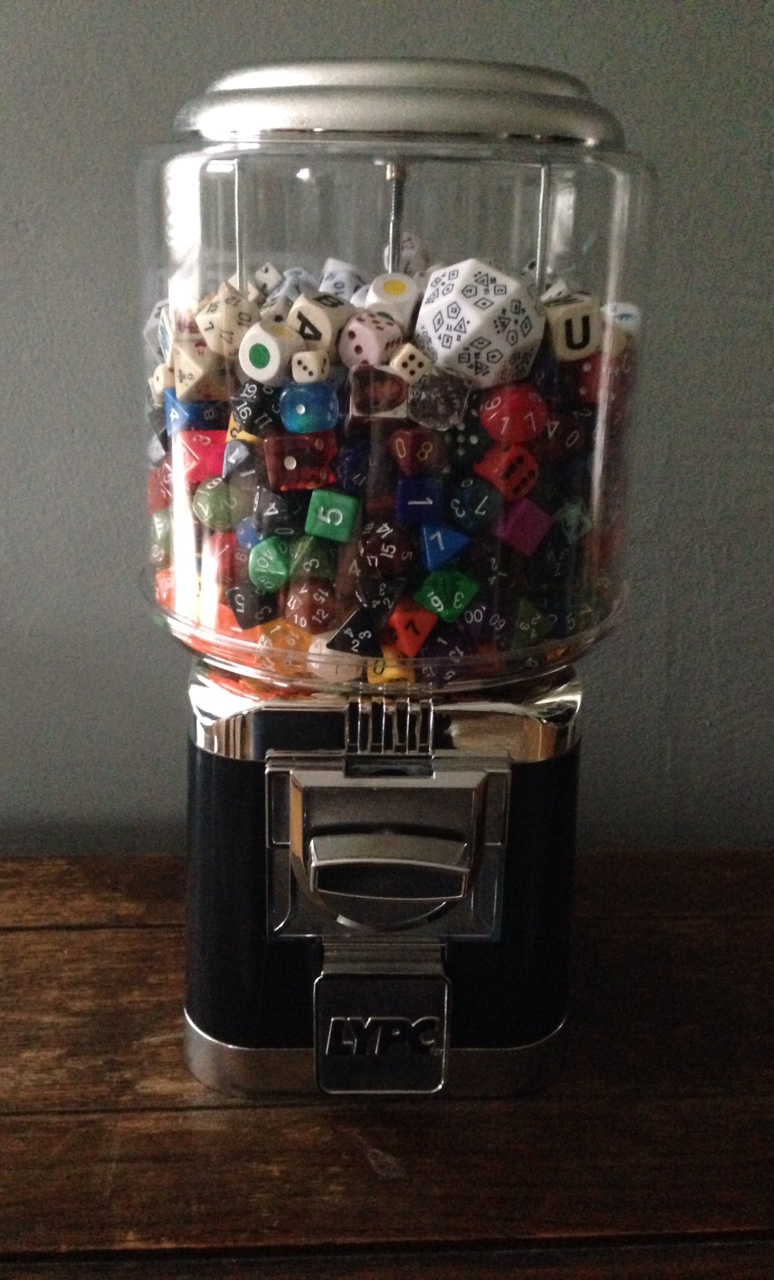 A few years back I told Jenn “You know what would be awesome? A gumball machine filled with dice.” I forgot about it… she didn’t. So meet the newest addition to our house. It’s just as awesome as I expected, but it’s not a small machine. Jenn included a few pounds of dice as part of the present, and I’ve added in all the loose dice I had around the house, but that’s still left us with a significant amount of room at the top. And that gave me an idea.
A few years back I told Jenn “You know what would be awesome? A gumball machine filled with dice.” I forgot about it… she didn’t. So meet the newest addition to our house. It’s just as awesome as I expected, but it’s not a small machine. Jenn included a few pounds of dice as part of the present, and I’ve added in all the loose dice I had around the house, but that’s still left us with a significant amount of room at the top. And that gave me an idea.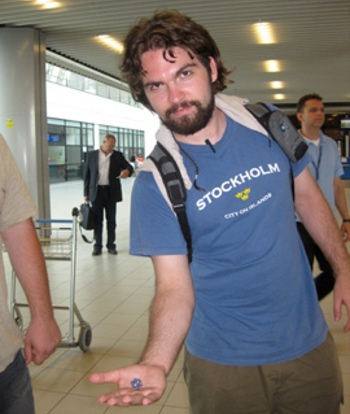 Dice aside, I love hearing people’s stories about how they started gaming, why they play, or favorite moments. It’s especially great to hear from people who have enjoyed something I’ve done – to hear YOUR stories of Eberron, Gloom, or anything else. Last year at Calgary Expo I met a pair of newlyweds who’d met in an Eberron campaign; the year before I met a soldier whose unit played Eberron in Iraq using dice made out of toilet paper.
Dice aside, I love hearing people’s stories about how they started gaming, why they play, or favorite moments. It’s especially great to hear from people who have enjoyed something I’ve done – to hear YOUR stories of Eberron, Gloom, or anything else. Last year at Calgary Expo I met a pair of newlyweds who’d met in an Eberron campaign; the year before I met a soldier whose unit played Eberron in Iraq using dice made out of toilet paper.
